
| February 2002 | ||||||
| Sun | Mon | Tue | Wed | Thu | Fri | Sat |
| 1 | 2 | |||||
| 3 | 4 | 5 | 6 | 7 | 8 | 9 |
| 10 | 11 | 12 | 13 | 14 | 15 | 16 |
| 17 | 18 | 19 | 20 | 21 | 22 | 23 |
| 24 | 25 | 26 | 27 | 28 | ||
Friday 01 February 2002
At 1200, EST the Training Ship Empire State was located 34 nautical miles west of Cabo San Antonio, Cuba at 21 degrees and 42 minutes North Latitude and 085 degrees 33 minutes West Longitude, steering course 154 degrees true at a speed of 13 knots/Rpm 68 turns. The weather was excellent; skies were clear, winds from the northeast at 15 to 20 knots, air temperature was 81 degrees Fahrenheit, barometric pressure was 1021 millibars, seas were from the northeast at 3 to 5 feet, sea injection temperature was 78 degrees Fahrenheit. Depth of water beneath the keel was 1770 meters.
CAPTAIN'S LOG
"If you don't understand that you work for your mislabeled "subordinates," then you know nothing of leadership. You know only tyranny."
- Dee Hock - Founder and CEO Emeritus, VISA International
Today, we are taking our leisurely time, meandering along and enjoying the view northeastward of the Yucatan Peninsula in the Yucatan Channel. The Channel separates Cuba from Mexico and it is a major passage between the Gulf of Mexico and the Caribbean Sea. The ocean currents are strong as water flows northward through the slip enroute to the southern end of the Atlantic's Gulf Stream. Sailing ships rode the current into the Gulf for centuries and it saved them time. Today, we buck the flow and it takes our money. (fuel)
The refreshing ocean breeze has been on the port bow and it was nicely amplified by our forward speed. It was welcome relief; as we struggled to deal with the hot and humid, the stiff breeze made our yoke easier to bear. I looked quickly at the New England weather synopsis this morning, and I saw that the homebound have been dealing with a humid front too, but of the "sub arctic" variety. I know that you feel our pain and we thank you for your concern. The winds are shifting aft to the port quarter, but with your continue help, we may survive.
Cadet VanEtten eloquently describes his growing love for all things Deckie in today's Cadet's Comment. I am thrilled; he is one of our cadet leaders and his input is important to the youngies who are struggling with decisions. They are often startled by the demands of their first sea term and the seniors show them all sides.
Meanwhile, the "deckie work" that enthrals cadet VanEtten, continues on the topside transformation; Cadets are hanging from the superstructure like new age monkeys, with rust on the run, and old paint, sticking around from cruises past, in deep doo - doo.

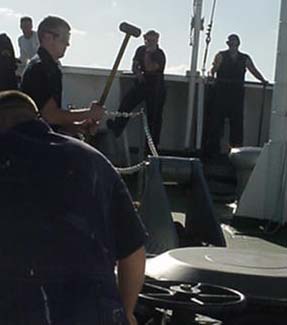
I have always been a lover of great music and the Caribbean is home to some of the finest; even now, the bulkheads are alive with the melodious sounds of the infamous TSES Chippenhammer Steel Band. This year the snare section is led by none other than Nedl Gunn, with Dek Crawler on heavy concussion. I love the whimsical sounds of wire brushes on welds followed by the colorful whispers of the wind section plying paint. They play just for me you know. Cadet VanEtten, eat your heart out!
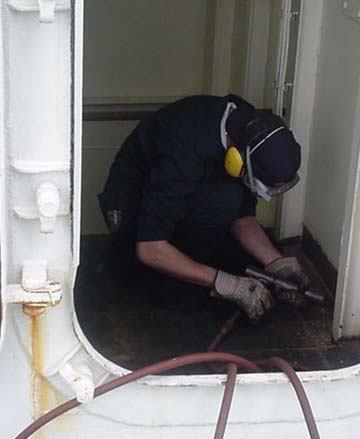
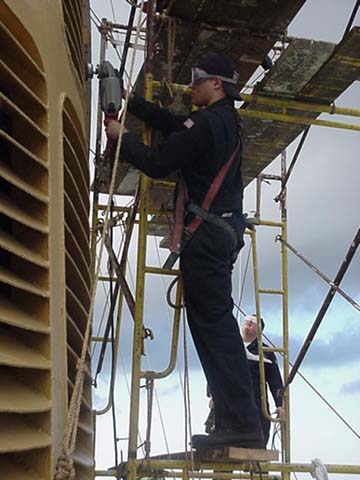
The harsh claps of thunder may well interrupt those harmonies as a cool front roars by. But a little atmospheric input won't ruin our concert. Instead, the low bass may add a nice touch and the cold front will further defeat the humidity. (another plus)
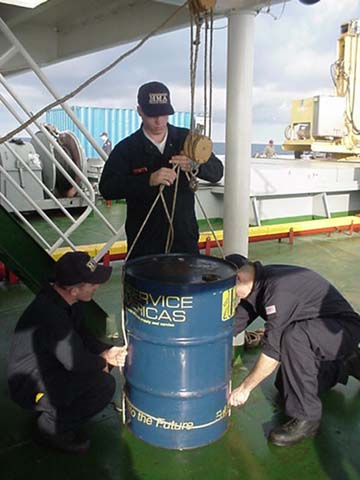
I noticed a great deal of activity around our motor whaleboats this morning. These small (26 foot) but very stable craft, are pointed at both ends and are excellent small boats in which to learn necessary boat handling skills. The deckies enlisted the help of several engineers and together, they were busily completing the "preflight" checks. Forever the optimists, they are preparing to commission the Sea Term Sea Taxis should they become necessary during our stop this weekend. They were also reviewing the lifeboat procedures so I know that they are anxious about doing well, tomorrow.
The Caymans are located nearly two hundred miles south of Cuba and are oriented west to east. Our anchorage is at the western tip of Grand Cayman, the western most of the islands. The Islands were discovered by Christopher Columbus in 1503 and we own him a debt of gratitude; what a nice place to stop. February is the driest part of the year so you guessed it...we will suffer under continued hot and dry conditions for at least a few more days. Drat!
We will drop anchor on the Caribbean's northern plateau not far from the deepest point in the Sea. That would be the Cayman Trench; Say you're afraid of heights? The bottom is a smidgen over 4, I say four, nautical miles straight down. The trench lies between Cuba and Jamaica and the waters around the trench are renown for superb deep-sea fishing. The best fishing occurs in the summer so I guess we aren't missing anything. Just tell that to the fisher faithful aboard.
Well folks, I must go. I know for whom I work and I hear them calling. The Chippenhammer Steel Band plays on...I shant miss a note. See you tomorrow from Georgetown, Grand Cayman.
CADET'S COMMENT

Why I Became A Deckie!! By 1/C Adam VanEtten
I am a senior Marine Transportation student here at MMA and I would like to take a moment to tell you why.
As a youngie, I tried something of all the majors, (then) Marine Engineering, Marine Safety, and Marine Transportation. Each was appealing and the choice was tough. Well, maybe not that hard!!
I experienced many things over the last 4 years, including the most beautiful sight in the world, sunset at sea. It's 6 o'clock in the evening, the sun is slowly sliding from the sky, the daylight dims and the sky turns brilliant orange, laced with ribbons of pink. Then comes the "Emerald Flash" when the ocean extinguishes the last rays of the setting sun. That beauty, a small perk for working atop the ship, is always hidden from those toiling in the engine room.
Then comes the time of evening stars. What a treat it is to join fellow cadets on the flying bridge to sight the first star or planet. Suddenly, someone yells out, "look, there's Jupiter" and everyone rushes to take the sight and compare figures. Celestial navigation is nearly as old as sailing itself but the satisfaction of fixing one's position by using starlight is as fulfilling today as it was way back when; In fact it is impressive! Then, to look into the velvet black of the clear night sky and see the universe twinkling back is pure joy that those trapped ashore or in the engineroom rarely know.
Now, I didn't become a Deckie just to watch the beautiful sunsets and evening stars, but it helped.
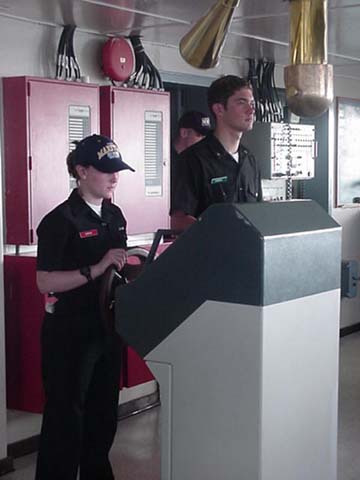 As a Deck Officer, one does many other things. For instance, collision at sea is not a good thing, so we always want to avoid other vessels. It's sometimes difficult to decide which way to go when a 900 foot tanker is approaching dead ahead, and three other ships are crowding the sea lane also. Knowing the Rules of the Road helps but one always wonders, does the other guy know them too? Think about bringing one of the giant super tankers into a small port or even through the narrow Cape Cod Canal. It seems impossible but Deck Officers do it everyday. Navigation is the key and using modern tools like the GPS in conjunction with visual fix information makes the task less onerous. That challenge is always something to anticipate.
As a Deck Officer, one does many other things. For instance, collision at sea is not a good thing, so we always want to avoid other vessels. It's sometimes difficult to decide which way to go when a 900 foot tanker is approaching dead ahead, and three other ships are crowding the sea lane also. Knowing the Rules of the Road helps but one always wonders, does the other guy know them too? Think about bringing one of the giant super tankers into a small port or even through the narrow Cape Cod Canal. It seems impossible but Deck Officers do it everyday. Navigation is the key and using modern tools like the GPS in conjunction with visual fix information makes the task less onerous. That challenge is always something to anticipate.
The Deck Department is also responsible for maintaining the exterior of the ship and those duties include tasks as diverse as cleaning the bridge windows and preparing 20-ton anchors. Certainly, not always the most enjoyable work, but the sense of pride that one feels when approaching his pristine ship makes the effort worthwhile. Deck is a rewarding choice, whether watching a beautiful sunset, navigating the world, or performing routine maintenance, I enjoy it. Choosing Engine was a close second but in the end, Engineer's can't become Captain. You have to be a DECKIE!
ANSWERS FOR FRIDAY 01 FEBRUARY
MATH: Two yards is 2 x 36 inches or 72 inches. The ratio of 4 inches to 72 inches is 4/72 or 1/18. Remember that in a ratio both numerator and denominator must be in the same units.
SCIENCE: Longitude lines are made by circles that intersect with both the North and the South Poles. Latitude is measured as an angle from the equator of the Earth (0°) to the North Pole (90° North) or to the South Pole (90° South).
GEOGRAPHY: Popocateptl, May 31 2001; Colima, May 26, 2001; Zacatecas, June 1997
HISTORY: The Aztec people were wandering through the lands of northern Mexico. The Aztec legend states that their tribal god, whose name meant "Humming Bird of the South", told them that they were to build their city in the spot where they saw an eagle perched on a cactus with a serpent in its beak. The eagle with a serpent was seen on an island in Lake Texcoco. That is where they built their capitol city Tetnochtitlan, now Mexico City.